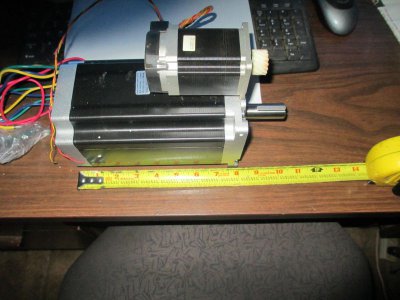Okay, couple more questions on stepper motors.
First is to do with physical size and weight.
What is the typical physical size and weight of NEMA 23, 34, and 42 stepper motors ?
For example, I have a Clausing 8520 mill that I’d like to install stepper motors on for direct drive of the axis, but really don’t want to have a 50 lb stepper motor that’s 12” long sticking out in 3 different directions that I'll have to engineer some sort of mounting system.
Second, how would you decide if going direct drive or geared drive via gearbox or belt & pulley as far as required motor size ?
If math is correct and works here, I could use a NEMA 23 CNC kit with 382 oz-in motors ($369) with a NEMA 23 5:1 planetary gearbox ($200 ea) for a total of $969 assuming 382 oz-in at 5:1 gear ratio would be the same as 1910 oz-in of torque, but with smaller, lighter, and cheaper motors.
I know this would not be a direct correlation since the motors would have to operate at a higher speed, hence lower torque, for the same feed rate, but I think you get my drift.
Third, what factors would you consider for sizing a 4th axis for say connecting to a rotary table or dividing head ? Since these type accessories have some degree or gearing integral to them, I’d think a small oz-in stepper could be used, but how would one decide on oz-in sizing ?
Forth, is there an easy way to direct control stepper motors without using a CNC program and/or computer ?
I want to add power feeds to at least 2 of my axis (getting tired of cranking, LOL).
Accordingly, my research has shown that I’d need something like a Servo Type 140 power feed for my X & Z axis. Looking on eBay and other suppliers, a Servo Type 140 power feed runs anywhere from $650 to $800 each. That totals somewhere between $1300 and $1600 for adding power feeds to 2 axis.
Now, looking at Automation Technologies, I can buy a 3 or 4 axis NEMA 34 CNC conversion kit with 1805 oz-in stepper motors and drivers for $1022 (3 axis kit) or $1350 (4 axis kit).
If I needed larger steppers, they have a NEMA 42 kit with 2830 oz-in motors for $1193 (3 axis kit) or $1712 (4 axis kit) or, as stated in the second item, using smaller motors with gearboxes.
From a purely financial aspect, it seems to make more sense to install manually controlled stepper motors than buying power feeds, plus being most of the way towards a full CNC conversion, if I so desired later.
Considering this since I know nothing about CAD/CAM other than what I’ve read here, but not wanting to rule out the possibility for later. If I knew I wanted to go CNC for sure, I’d more likely sell what I have and just buy a Tormach or a Precision Mathews mill that’s already a CNC machine.

